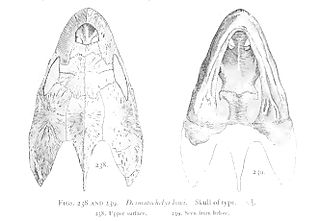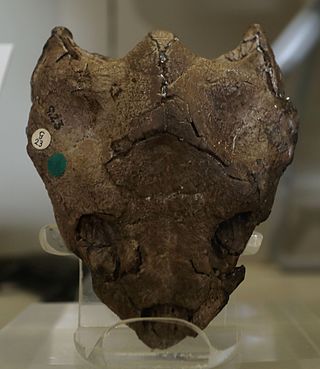
Axel Heiberg Island is an uninhabited island in the Qikiqtaaluk Region, Nunavut, Canada. Located in the Arctic Ocean, it is the 32nd largest island in the world and Canada's seventh largest island. According to Statistics Canada, it has an area of 43,178 km2 (16,671 sq mi). It is named after Axel Heiberg.

Pachyrhinosaurus is an extinct genus of centrosaurine ceratopsid dinosaur from the Late Cretaceous period of North America. The first examples were discovered by Charles M. Sternberg in Alberta, Canada, in 1946, and named in 1950. Over a dozen partial skulls and a large assortment of other fossils from various species have been found in Alberta and Alaska. A great number were not available for study until the 1980s, resulting in a relatively recent increase of interest in Pachyrhinosaurus.

Protostega is an extinct genus of sea turtle containing a single species, Protostega gigas. Its fossil remains have been found in the Smoky Hill Chalk formation of western Kansas, time-equivalent beds of the Mooreville Chalk Formation of Alabama and Campanian beds of the Rybushka Formation. Fossil specimens of this species were first collected in 1871, and named by Edward Drinker Cope in 1872. With a total length of 3.9 metres (13 ft), it is the second-largest sea turtle that ever lived, second only to the giant Archelon, and one of the three largest turtle of all time along Archelon and Gigantatypus.
The High Arctic Large Igneous Province (HALIP) is a Cretaceous large igneous province in the Arctic. The region is divided into several smaller magmatic provinces. Svalbard, Franz Josef Land, Sverdrup Basin, Amerasian Basin, and northern Greenland are some of the larger divisions. Today, HALIP covers an area greater than 1,000,000 km2 (390,000 sq mi), making it one of the largest and most intense magmatic complexes on the planet. However, eroded volcanic sediments in sedimentary strata in Svalbard and Franz Josef Land suggest that an extremely large portion of HALIP volcanics have already been eroded away.
Canadaga is a flightless bird genus from the Late Cretaceous. The single known species is Canadaga arctica. It lived in the shallow seas around what today is Bylot and Devon Islands in Nunavut, Canada. Its fossils were found in rocks dated to the Campanian to mid-Maastrichtian age, about 67 million years ago.

Bothremydidae is an extinct family of side-necked turtles (Pleurodira) known from the Cretaceous and Cenozoic. They are closely related to Podocnemididae, and are amongst the most widely distributed pleurodire groups, with their fossils having been found in Africa, India, the Middle East, Europe, North America and South America. Bothremydids were aquatic turtles with a high morphological diversity, indicative of generalist, molluscivorous, piscivorous and possibly herbivorous grazing diets, with some probably capable of suction feeding. Unlike modern pleurodires, which are exclusively freshwater, bothremydids inhabited freshwater, marine and coastal environments. Their marine habits allowed bothremydids to disperse across oceanic barriers into Europe and North America during the early Late Cretaceous (Cenomanian). The youngest records of the group are indeterminate remains from Saudi Arabia and Oman, dating to the Miocene.

Desmatochelys is an extinct genus of sea turtles belonging to the family Protostegidae. This genus contains two known species, D. lowii and D. padillai. D. lowii was first discovered in 1895, followed by D. padillai in 2015. Having been estimated at over 120 million years old, D. padillai is currently the oldest known species of sea turtle.

Paleontology or palaeontology is the study of prehistoric life forms on Earth through the examination of plant and animal fossils. This includes the study of body fossils, tracks (ichnites), burrows, cast-off parts, fossilised feces (coprolites), palynomorphs and chemical residues. Because humans have encountered fossils for millennia, paleontology has a long history both before and after becoming formalized as a science. This article records significant discoveries and events related to paleontology that occurred or were published in the year 2009.
Kirgizemys is an extinct genus of turtle from Early Cretaceous of China, South Korea, Mongolia, Russia and Kyrgyzstan.

Dorsetochelys is an extinct genus of turtle from the Early Cretaceous of southern England and northwestern Germany.
Paleontology or palaeontology is the study of prehistoric life forms on Earth through the examination of plant and animal fossils. This includes the study of body fossils, tracks (ichnites), burrows, cast-off parts, fossilised feces (coprolites), palynomorphs and chemical residues. Because humans have encountered fossils for millennia, paleontology has a long history both before and after becoming formalized as a science. This article records significant discoveries and events related to paleontology that occurred or were published in the year 2010.
Kinkonychelys is an extinct genus of side-necked turtle which existed in Madagascar during the Late Cretaceous period. It contains the single species Kinkonychelys rogersi, named in honor of its discoverer, Raymond R. Rogers. The genus and species are based on UA 9748, a nearly complete skull, which represents the first turtle skull described from the pre-Holocene era in Madagascar. A number of isolated skull and jaw bones have also been assigned to K. rogersi. These specimens were found in rocks of the Maastrichtian-age Maevarano Formation in the Mahajanga Basin of northwestern Madagascar. Another specimen, FMNH PR 2446, is speculated to represent another species, currently known as Kinkonychelys sp., but consensus on its distinction from K. rogersi remains unclear.
Hutchemys is an extinct genus of softshell turtles from the late Cretaceous to the late Paleocene of New Mexico, Montana, Wyoming, Utah, and North Dakota, United States. It was first named by Walter G. Joyce, Ariel Revan, Tyler R. Lyson and Igor G. Danilov in 2009, and the type species is Hutchemys rememdium. H. rememdium is known from the holotype YPM PU 16795, which consists of a nearly complete postcranial skeleton, and from the referred specimen YPM PU 16781, found in the Ekalaka Member of the Fort Union Formation, Montana. Another referred specimen, YPM PU 14985, was found in the Cedar Point Quarry, Wyoming. The second species, H. arctochelys, is known from the holotype YPM PU 16319, a nearly complete carapace, and from the paratypes YPM PU 16320, YPM PU 16321, YPM PU 16322, YPM PU 16238. All specimens of H. arctochelys were recovered from the same quarry of the Tongue River Member, Fort Union Formation, near Burns Mine of Montana. A possible third species is represented by the unnamed specimen UCMP 130000 from the Paleocene Tullock Formation of Montana. Aspideretes? nassau (YPM PU 11566) from the Fort Union Formation, Duffy's Ranch of Sweet Grass County, Montana was also assigned to Hutchemys sp. A fourth species of Hutchemys, Hutchemys walkerorum, has been uncovered from the Hell Creek Formation of North Dakota. H. walkerorum is known from the holotype BDM 063, identified by the discovery and assembly of portions of its carapace. The fossil of H. walkerorum suggests that it was the only Hutchemys to live exclusively during the late Cretaceous era.
Eugene S. Gaffney is an American paleontologist and leading authority on the morphology and evolutionary history of turtles.

Trionyx is a genus of softshell turtles belonging to the family Trionychidae. In the past many species in the family were classified in this genus, but today T. triunguis, the African or Nile softshell turtle, is the only extant softshell still classified as Trionyx. The other species still assigned to this genus are only known from fossils. T. triunguis is a relatively large, aquatic piscivore.

Macrobaenidae is an extinct family of turtles, known from the Early Cretaceous to Paleogene of Laurasia. Their relationships to other turtles and whether they form a monophlyletic group are controversial. They are typically interpreted as stem or crown group cryptodires, but some more recent analyses have found them to lie outside crown group Testudines. Macrobaenids can be distinguished from other testudinatans by the presence of a carotid fenestra, cruciform plastron with strap-like epiplastra, and a lack of extragulars.
Arvinachelys goldeni is an extinct baenid turtle from the Late Cretaceous of Utah. A. goldeni is notable among turtles for the presence of two nasal openings instead of one, giving it a vaguely pig-nosed appearance in life.

Basilemys is a large, terrestrial nanhsiungchelyid turtle from the Upper Cretaceous of North and Central America. Basilemys has been found in rocks dating to the Campanian and Maastrichtian subdivisions of the Late Cretaceous and is considered to be the largest terrestrial turtle of its time. In an analysis made by Sukhanov et al. on a nansiunghelyid turtle from the Upper Cretaceous of Mongolia, it was demonstrated that Asian nanhsiungchelyids gave rise to the North American nanhsiungchelyids.

Tingmiatornis is a genus of flighted and possibly diving ornithurine bird from the High Arctic of Canada. The genus contains a single species, T. arctica, described in 2016, which lived during the Turonian epoch of the Cretaceous.
Anatolemys is an extinct turtle genus in the family Macrobaenidae. Two species are known, both of which lived in the Late Cretaceous. Fossils were discovered in the Yalovach Formation of Tajikistan, the Kulbikin Member and Khodzhakul and Bissekty Formations of Uzbekistan and the Bostobe Formation of Kazakhstan. With 70 cm (2.3 ft) in carapace length, Anatolemys maximus was one of the three largest macrobaenids along with Early Cretaceous Yakemys multiporcata and Paleocene Judithemys backmani.












